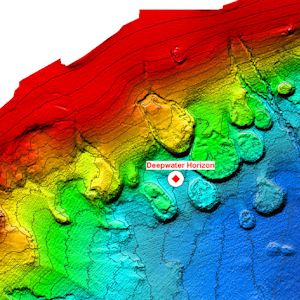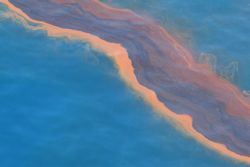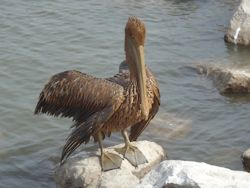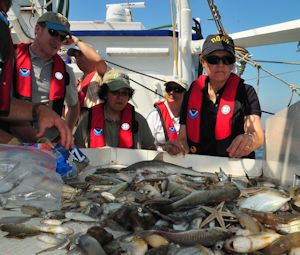SEJournal Online is the digital news magazine of the Society of Environmental Journalists. Learn more about SEJournal Online, including submission, subscription and advertising information.

April 20, 2015, marks the fifth anniversary of the BP Deepwater Horizon oil spill in the Gulf of Mexico, one of the largest environmental disasters in U.S. history. Its impacts are still reverberating. And the story is far from over. If you are covering the legacy of the spill, this month the Society of Environmental Journalists is offering two special TipSheets that will help you get the facts and background. Both were done by Amy Wold, who has been covering the spill for the Baton Rouge/New Orleans Advocate. The first is "Follow the Money" and the second is "Follow the Science" (below).
BP Deepwater Horizon Anniversary: Follow the Science
By Amy Wold for the Society of Environmental Journalists
 |
|
NOAA's Office of Coast Survey constructed this digital terrain model of the sea floor in the vicinity of the Deepwater Horizon oil rig using multibeam survey data collected during the 1990s. The hydrographic data and model can help experts better understand ocean circulation. Credit: NOAA |
On April 20, 2010, 11 men lost their lives when the Deepwater Horizon drilling platform exploded in the Gulf of Mexico off the coast of Louisiana.
For the next 87 days, the nation and world watched as repeated attempts were made to cap the well that eventually released almost five million barrels of oil into the Gulf of Mexico before finally being capped in July.
As the five-year anniversary approaches, reporters will want to look at the history of early and ongoing research into the impacts this spill had on fish and wildlife in the Gulf of Mexico region.
This lengthy publication from Louisiana State University (LSU) focuses on the university's role in oil spill response. It starts with a good timeline of the oil spill itself. At the end (starting on page 113), reporters will find a list of professors and researchers who can talk about various areas of research done or being done on the spill.
Even before the well was capped, the National Science Foundation started awarding rapid response grants to begin looking at potential impacts the spill was having or expected to have.
Here are links to some of those early studies:
- Gulf of Mexico Oil Spill's Effects on Deep-Water Corals
- Chemical Make-up of Gulf of Mexico Oil Plume Determined
- Gulf of Mexico Topography Played Key Role in Bacterial Consumption of Deepwater Horizon Spill
- Gulf Oil Spill: NSF Funds Research on Impacts to Florida Everglades
- Gulf Oil Spill: Mississippi River Hydrology May Help Reduce Oil Onshore
- Gulf Oil Spill: NSF Awards Grant to Study Effects of Oil and Dispersants on Louisiana Salt Marsh Ecosystem
- Gulf Oil Spill: NSF Awards Rapid Response Grant to Study Oil Found on Alabama, North Florida Beaches
- NSF Awards Rapid Response Grant for Study of Vibrio Bacteria in Gulf Oyster Beds
- Gulf of Mexico Deepwater Horizon Spill Effects on Fish Revealed
- Scientists Map Origin of Large, Underwater Hydrocarbon Plume in Gulf
In May 2010, BP made a commitment to set aside $500 million over a 10-year period to pay for research on the impacts of the oil spill. This money formed the Gulf of Mexico Research Initiative, whose site is here and which can be searched for specific research here.
 |
|
Heavy band of oil seen during an overflight on May 12, 2010. Credit: NOAA |
A part of this Gulf of Mexico Research Initiative was the formation of collaboration among universities. A list of what money went to which universities and researchers for specific projects is here.
An example of these is the Coastal Waters Consortium, led by the Louisiana University Marine Consortium, to look at a variety of issues including how the oil and dispersants impacted coastal wetlands and food webs.
Human health impacts have also been a big question in the wake of the oil spill, with one of the main problems being the lack of any long-term examination of human health post-spill.
The National Institute of Environmental Health Sciences is attempting to change that and partnered with various universities to look at human physical and mental health effects of the oil spill.
Here's a list of partners:
BP also keeps a Deepwater Horizon accident and response page.
The National Oceanic and Atmospheric Administration has a number of resources on impacts, research and restoration links. Lots of basic information as well as images are linked here.
While initial concerns about seafood in the Gulf of Mexico revolved around whether it was safe for human consumption — no major problems were reported — the real question is what the long-term impacts will be, not just on human health, but on the health of seafood species themselves. Largely, because of the time it takes to weed out natural ups and downs, the question is still out there. However, there have been studies that suggest there is a reason to keep looking.
In 2011, there was a study by LSU researchers that showed there were developmental problems in killifish after exposure to even low concentrations of Deepwater Horizion oil.
Researchers with NOAA have also said the ongoing unusual mortality event of dolphins in the Gulf of Mexico have links to the Deepwater Horizon spill. Here's a report which has lots of graphs and number as well as a relatively new study published on Feb. 11, 2015.
Marsh life and food webs were also impacted. Here are early results from work looking at insects in coastal marsh areas impacted by the oil spill.
As time goes on there is still the question of where all the oil went. Some was cleaned up, some ended up in the marsh where it was almost impossible to remove, while some evaporated or was consumed by bacteria.
One study suggests that the microbes weren't as effective as assumed in all cases.
Another recent study looks at how a portion ended up on the ocean floor.
 |
|
Louisiana Department of Wildlife and Fisheries biologists found an oiled Brown Pelican, Louisiana’s official state bird, on the rocks along Bayou Rigaud, across from Sand Dollar Marina on Thursday, May 13, 2010. Biologists collected the pelican and brought it to veterinarians for rehabilitation. Credit: LDWF Biologists |
There's no more iconic image of the Deepwater Horizon oil spill than a pelican covered in oil and the fate of birds as the spill continued to be cleaned up remained a concern.
This is the U.S. Fish and Wildlife Service information on bird impact.
The research continues beyond just the initial and recent impacts. The Resources and Ecosystems Sustainability, Tourist Opportunities and Revived Economies of the Gulf Coast States Act (RESTORE Act) allocates 80 percent of civil penalties from the Deepwater Horizon to state and local efforts. One of those is the designating of Research Centers of Excellence in the five Gulf of Mexico States.
- Florida – Florida Institute of Oceanography
- Alabama – Dauphin Island Sea Lab
- Mississippi – The University of Mississippi’s Center for Gulf Studies
- Louisiana – The Water Institute of the Gulf
- Texas – Two consortiums with multiple universities
More information will come out as well after the Natural Resource Damage Assessment (NRDA) process, as set out by the 1990 Oil Pollution Act. It is a legal process that works to determine how much damage was done by an oil spill and then the parties — in this case the states, federal government and companies — make their case for a dollar amount.
It's a process that can take years.
Here is a report from the Congressional Research Service about the Deepwater Horizon NRDA process from July 2013.
Because of the delay between the spill and when NRDA will be completed, BP agreed to a $1 billion early restoration "down-payment" to get some restoration work started early while the overall process continues. Several rounds of funding have been handed out, with details here.
BP also has been running its own website focused on the Deepwater Horizon disaster since Oct. 31, 2013. The site includes responses to the study on the unusual mortality event for dolphins, reactions to court orders, links to environmental information collected as part of the Natural Resource Damage Assessment process, and more.
There is also a series of BP-produced fact sheets on various topics:
- Fact sheets on StateoftheGulf.com
- Gulf Coast recovery fact sheet
- Early Restoration Project fact sheet
- Claims information
- Geoff Morrell, BP Senior Vice President for US Communications and External Affairs, speech to SEJ annual conference in 2014.
BP contact for information involving Deepwater Horizon: Jason Ryan, BP America Press Officer, (713) 323-4242, jason.ryan@bp.com. Send a second email to the BP US Press office at USPRESS@BP.COM or call (281) 366-4463, in case Jason Ryan is traveling.
BP released a report on March 16, 2015, which concludes that the Gulf of Mexico is close to being recovered back to the state it was in before April 20, 2010.
 |
|
NOAA Administrator Dr. Jane Lubchenco, NOAA Fisheries Assistant Administrator Dr. Eric Schwaab, and Council on Environmental Quality Chair Nancy Sutley assess how the sample is processed aboard the Research Vessel Caretta and chain of custody protocol used when handling specimens associated with the oil spill. Credit: NOAA |
However, environmental groups and the state say that's absolutely not the case and that BP "cherry picked" studies to only include those that have positive things to say about the Gulf ecosystem recovery. Many other studies, they say, point to potential problems and only time will tell how those long-term impacts will play out. At the same time, the Natural Resource Damage Assessment process designed to detail damage, and costs BP would need to pay to repair those damages, is still years away from being completed.
Human health effects of the oil spill also became a concern, from mental health effects of the stress dealing with an uncertain future to whether Gulf of Mexico seafood was safe to eat.
The National Institute of Environmental Health Science is conducting a five-year, $25-million program called the Deepwater Horizon Research Consortia to look at some of these impacts.
The Centers for Disease Control and Prevention's National Institute of Occupational Safety and Health also had a role in the response and this link includes summaries of those efforts as well as a Health Hazard Evaluation of Deepwater Horizon Response Workers. Although this came out in August 2011 it does give a background to the response.
For additional reading:
- A good set of links from ProPublica on the ongoing story of the oil spill.
- Another good set of links from the Times-Picayune/NOLA.com coverage, with links to infographics and maps.
- Oil spill believed to have accelerated Louisiana's coastal land loss: "Washed Away" and "Bird Habitat Also Lost As Plants Die," The Advocate, by Amy Wold.












 Advertisement
Advertisement 



